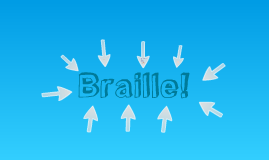Braille ~ Louis Braille
Transcript: A drawing of Louis Braille ----------> "Louis Braille Biography" Encyclopedia of World Biography. January 26, 2015 <www.notableboigraphies.com/Br-Ca/Braille-Louis.html> "Braille" Britannica School. January 27, 2015 <school.eb.com/levels/middle/article/273326> "An Overview of Braille" Indiana University. January 29, 2015 <www.indiana.edu/~iuadapts/services/braille.html> BOOKS Donaldson, Madeline. Louis Braille. Minneapolis: Lerner 2007. Alder, David A. A Picture Book of Louis Braille. New York: Holiday House, 1997 Accomplishments and Setbacks Braille ~ Louis Braille The benefits of Raphigraphy was so that blind people could read easier. Some of the problems of Raphigraphy is that (some) sighted people can't read it because they don't need to or don't want to. This problem can be fixed and the way to fix the problem is for sighted people to learn Braille by taking classes or learning from blind people. I think that fixing the problem could be useful because if the book that you wanted to read was in braile, and you didn't know the title of the book, or if you wanted to read the book but it was only in Braille, you could learn Braille and read the book that you wanted. The Braille System --------------------> Video Link 1. Louis died of Tuberculosis on January 6, 1952. 2. The letter "w" was not originally put into Braille because words that started with a ''w'', like Wednesday and weekend, came from other languages. 3. Before Louis went to school to learn at The National Institute of Blind Youth, the school was a prison. King Louis Philippe ----> Bibliography The National Institute of Blind Youth ----> Someone reading Braille ------------> Society's Impact Raphigrapghy had a big impact on society because now, blind people can read! Raphigraphy was originally Braille, but people wanted to remember Louis, so they changed it to Braille. I don't really think that this change had a HUGE impact on society, but Braille is probably more well known than Raphigraphy. The Invention (part 1) The Invention (part 2) From prison to school for the blind ----------------------> Louis started expirimenting with cut shapes before he made Braille. Captain Charles Barbeir inspired Louis when Charles gave the students a lecture at the National Institute of Blind Youth. Louis learned that if you don't like the way somthing is, you have the creativity to change it. The only problem that was in his way was Tuberculosis. Tuberculosis had been spreading all throughout his school. Professional Career Someone Reading Braille <------- Interesting Facts Background Information Made by Caitlyn Frazier Louis Braille was born in Coupvray, France, on January 4, 1809. Louis' father was a saddle maker. His father was Simon-Rene Braille, his mother was Monique Baron-Braille, and his siblings are unknown. He also studied at the National Institute of Blind Youth. FYI: Embossed lettering was the first type of Braille, but Louis did not create the Embossed Lettering System. Louis Braille created a new way for blind people to read. Louis created Braille around 1839, but it was first called Raphigraphy. Louis created Raphigraphy so that blind people could read in an easier way than the Embossed Lettering System. Louis created a new way for blind people to read. Louis was noticed by a king for his new way of reading, Louis also played instuments in some churches, and Louis was a spectacular student in school even though he was blind. Even though people liked his way of reading, King Louis Philippe liked his idea, but sighted teachers were worried about smart, blind teachers stealing their jobs, so the King decided to stick with the Embossed Lettering system.

















